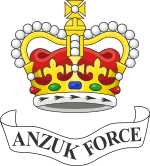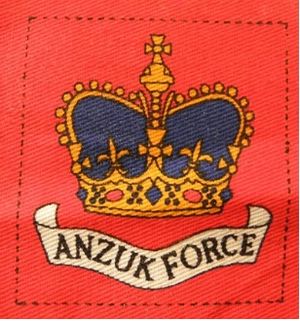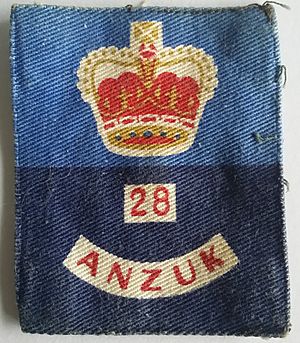ANZUK facts for kids
Quick facts for kids ANZUK |
|
|---|---|
 |
|
| Active | 1 November 1971 – 31 January 1974 |
| Country |
|
| Garrison/HQ | Singapore |
| Commanders | |
| Notable commanders |
|
| Insignia | |
| Flag of ANZUK |  |
ANZUK was a special military team. It was made up of soldiers, sailors, and air force members from Australia, New Zealand, and the United Kingdom. Their job was to help protect the Asian Pacific region. This force was created after the United Kingdom decided to move many of its military forces out of areas "east of Suez" (meaning east of the Suez Canal) in the early 1970s.
The ANZUK force officially started in Singapore on 1 November 1971. Its first leader was Rear Admiral David Wells. The force worked together for a few years before it was officially ended on 31 January 1974.
Contents
How ANZUK Was Organized
ANZUK was made up of different military groups from the three countries. Here are some of the main parts:
The Main Headquarters
This was the central command for the whole ANZUK force. It included:
- 9 ANZUK Signal Regiment: This group handled all the communications for ANZUK. They used radio stations and other equipment to make sure everyone could talk to each other. They had people from Australia, New Zealand, and the UK, plus local workers from Singapore.
- ANZUK Traffic Management Agency (ATMA): Helped manage movement and transport.
- ANZUK Intelligence and Security Unit: Gathered information and kept things safe.
- 65 Ground Liaison Section: Helped coordinate air and ground operations.
- ANZUK Provost Unit: Acted like military police.
The naval part of ANZUK included warships and submarines:
- Two frigates (smaller warships) from the Royal Navy (UK).
- One frigate from the Royal Australian Navy (Australia).
- One frigate from the Royal New Zealand Navy (New Zealand).
- A submarine from either the UK or Australia.
Soldiers on Land (Land Component)
The soldiers on the ground were part of a group called the 28th Commonwealth Infantry Brigade Group. This group moved from Malaysia to Singapore and was renamed for ANZUK.
The 28th ANZUK Brigade
This was the main fighting force on land. Its commanders were:
- Brigadier Michael Walsh (1971–1972)
- Brigadier Michael Kennedy (1972–1974)
The brigade included:
- 28 (ANZUK) Brigade HQ and Signal Squadron: The headquarters and communication team for the brigade.
- Infantry Battalions: These were the main groups of soldiers.
- 6th Battalion, Royal Australian Regiment (from Australia).
- 1st Battalion Royal New Zealand Infantry Regiment (from New Zealand).
- 1st Battalion Royal Highland Fusiliers (from the UK).
- 28th ANZUK Field Regiment: This group had artillery (big guns) to support the soldiers.
- A combined Australian/British Headquarters Battery.
- 1st Battery Royal Artillery "The Blazers" (from the UK).
- 106th Field Battery, Royal Australian Artillery (from Australia).
- 161 Battery Royal New Zealand Artillery (from New Zealand, for 1972 only).
- 28 ANZUK Field Squadron: Engineers who built things and cleared obstacles.
- 28 ANZUK Aviation Squadron: Had helicopters for scouting and transport.
ANZUK Support Group
This group provided important services like transport, supplies, and repairs.
Transport Element
- Managed all the vehicles and movement of people and goods.
- Included a main transport unit with different platoons (smaller groups) for moving supplies and people.
- Also had a supply depot for storing goods and a postal unit for mail.
Ordnance Element
- ANZUK Ordnance Depot: This was like a giant warehouse for military supplies. It stored everything from spare parts to ammunition. It was run by people from Australia, New Zealand, and the UK, along with local workers.
Workshop Element
- ANZUK Area Workshops: This was where vehicles and equipment were repaired.
Planes and Pilots (Air Component)
The air force part of ANZUK included different types of aircraft:
- No. 3 Squadron RAAF (Australia) with Dassault Mirage III fighter jets.
- No. 41 Squadron RNZAF (New Zealand) with Bristol Freighter transport planes and Bell UH-1H Iroquois helicopters.
- No. 75 Squadron RAAF (Australia) with Dassault Mirage III fighter jets.
- No. 103 Squadron RAF (UK) with Westland Whirlwind (and later Westland Wessex) helicopters.
- No. 205 Squadron RAF (UK) with Avro Shackleton patrol planes.
Dress Distinctions
Soldiers from Australia, New Zealand, and the UK wore their own country's uniforms. However, they added special patches to show they were part of ANZUK:
- ANZUK Headquarters and Support elements wore this patch:
- 28 ANZUK Brigade Units wore this patch:
The naval and air force members usually did not wear these patches. This is because their ships and planes were still mainly under their own country's command. They only worked with ANZUK when needed.
Why ANZUK Ended
By 1973, the governments in Australia and the United Kingdom had changed their minds about keeping a large force in Southeast Asia. They decided that ANZUK should be ended.
Rear Admiral Wells, who helped start ANZUK, was in charge of planning how to slowly close down the force. Air Vice Marshal Richard Gordon Wakeford then took over to finish the process.
- Australia decided to keep a smaller military presence in Butterworth, Malaysia.
- The United Kingdom decided to remove almost all its forces from "east of Suez."
- New Zealand wanted to keep a military presence in Southeast Asia. So, on 30 January 1974, the New Zealand Force South East Asia was created. It took over all the New Zealand units that were part of ANZUK.
Throughout 1974, the different parts of ANZUK were gradually closed down. On 31 January 1974, ANZUK officially stopped existing. The naval and air force groups went back under their own country's command. What was left of the UK's land forces became the 28th (UK) Infantry Brigade.
It took several years for all the Australian and UK units to fully leave. By 1977, the NZFORSEA was the only foreign military group still based in Singapore.
See also
- ABCA Armies (the American, British, Canadian, Australian and New Zealand Armies' Program) optimises interoperability
- Five Power Defence Arrangements (signed in 1971) between Australia, Malaysia, New Zealand, Singapore and the United Kingdom (all Commonwealth members)




